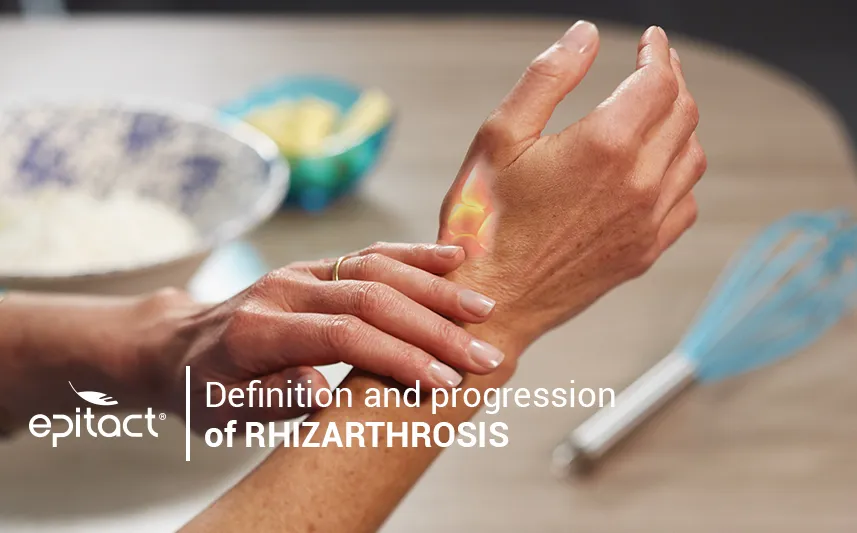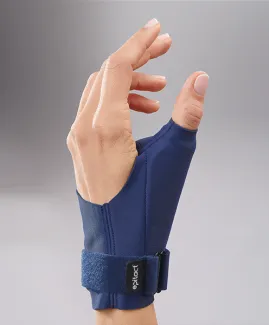
Basal thumb arthritis is a frequent disease that mainly affects women over 50 years old. As it progresses, the severity of symptoms increases, causing disabling pain, reduced hand strength and a thumb deformity.
This is why basal joint arthritis in the thumb has been classified according to 4 stages. Focus on this chronic and frequent condition: what is basal thumb arthritis and its stages? How to relieve it and limit the progression of symptoms? EPITACT® explains everything to you.
What is basal thumb arthritis?
For you to understand the disease and how it appears, let’s begin with a short explanation of the anatomy of the joints at the base of the thumb.
The thumb: a complex joint
The base of the thumb, close to the wrist, is composed of a set of bones that are articulated to each other. These bones are the scaphoid, trapezium and first metacarpal bone, which is in contact with the trapezium bone (hence the name of trapeziometacarpal bone). It makes a multidirectional joint. It allows a large rotational range of motion of the thumb (called circumduction).
Definition of arthritis in the thumb
Basal thumb arthritis is arthritis at the basal joint of the thumb. It is also referred to as thumb osteoarthritis, which is the most common type of arthritis. It often affects both hands.
Arthritis in the thumb is the degeneration of the cartilage of the affected joint. This is a chronic disease, which means it is a persistent and long-lasting condition. This progression is very slow and spreads over 10 years(1). Most of the time, it comes with time, because age is often related to overuse of the joints. By the way, we will see that some people are more exposed to the disease according to their jobs, sports activity or hobbies.
What does thumb arthritis feel like?
Basal thumb arthritis causes pain at the base of the thumb, joint stiffness and loss of strength of the thumb-index pinch grip. These symptoms of thumb arthritis are likely to impair the ability to do daily activities. The condition can also progress by inflammatory flare-ups, which prove to be particularly painful. In the most severe stages of basal thumb arthritis, a deformity of the thumb appears, usually in a Z-shape or M-shape in some cases.
Thumb osteoarthritis: painful wear of the thumb joint
The affected areas are different according to people: if the wear concerns the joint between the wrist bone (trapezium) and the thumb metacarpal bone (base of the thumb), we talk about trapeziometacarpal arthritis (TMC joint) or carpometacarpal joint (CMC joint). If the wear concerns the joint between the two wrist bones; the scaphoid and trapezium, we talk about scaphotrapezio-trapezoid arthritis (STT).
Arthritis of the TMC joint is the most common type of basal thumb arthritis.
By examining the symptoms of arthritis in the thumb, you will be able to identify the warning signs and to limit the progression of the condition.
The 4 stages of basal thumb arthritis
What is basal thumb arthritis stage 1, 2, 3 and 4? Those stages have been classified by several theorists(2, 3, 4).
Here, we focus on the Dell classification that determines 4 stages of basal thumb arthritis(2).
- the first stage corresponds to joint space narrowing without subluxation (movement of bones in the joint) or osteophytes (formation of bone spurs near the joint).
- the second stage of arthritis in the thumb involves slight subluxation that can still be treated and early stage osteophytosis.
- the third stage refers to osteophytosis with significant joint space narrowing and advanced stage subluxation.
- the fourth and last stage of basal thumb arthritis consists of complete destruction of the joint space, with prominent osteophytes, geodes (cysts) and ankylosis of the trapeziometacarpal joint.
Solutions to relieve arthritis in the thumb
We briefly said that overuse of the joint was a major risk factor of basal thumb arthritis. So the first line of treatment is based on joint rest and anti-inflammatory medication. Indeed, you can limit the movements that contribute to the cartilage wear and tear, either thanks to ergonomic tools at work, at home or with thumb support braces.
EPITACT® has developed two thumb supports for basal thumb arthritis. Because it is a chronic and painful condition, we have concentrated our efforts on creating devices with optimal comfort, durability and practicality of use.
The thumb brace for rest* aims to limit tenderness at the base of the thumb for more peaceful nights. You can wear it during rest periods the day, at night or during painful flare-ups. Also, EPTACT® has innovated a flexible thumb support for activities* that eases pain and helps to correct inappropriate movements intuitively.
You now understand better what is basal thumb arthritis and its 4 stages. For more details about the causes and treatments of arthritis in the thumb, EPITACT® suggests additional articles!
*These solutions are class I medical devices that bear the CE marking under this regulation. Carefully read the instructions before use. Manufacturer: Millet Innovation. 09/2021
For more details about this general and simplified approach, here are further sources:
(1)Delcambre B, Bera-Louville A, Guyot-Drouot MH. Osteoarthritis of the fingers and trapeziometacarpal joints. Joint Bone Spine 2001;68:339–47.
(2)Dell PC, Brushart Tm, Smith RJ. Treatment of trapeziometacarpal arthritis: results of resection arthroplasty. J Hand Surg 1978;3:243–9.
(3)Eaton RG, Glickel SZ. Trapeziometacarpal osteoarthrosis staging as a rationale for treatment of trapezo metacarpal osteoarthrosis. Hands Clinics 1987;3:455–69.
(4)Comtet JJ, Gazarian A, Fockens W. Definition and classification of basal joint osteoarthritis. A critical analysis and proposals. Treatment options. Chir Main. 1 févr 2001;20(1):5‑10.
 Pharmacie
Pharmacie

